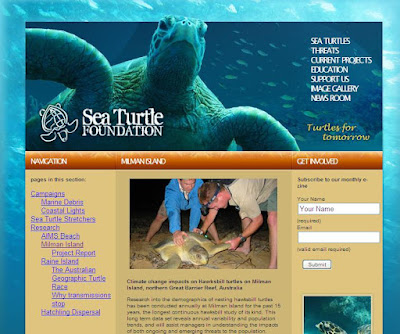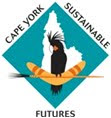Tuesday, October 19, 2010
A flatback sea turtle returns after laying her clutch of eggs at Crab Island, Cape York
Thursday, March 25, 2010
Cape York turtle deaths
This wet season has seen a number of cyclones/ tropical lows move into the Gulf of Carpenteria. These storms bring strong winds that push nets and debris onto the beaches of western Cape York. In the path of these nets are countless marine life, including many sea turtles. On Pennefather Beach alone over 60 turtles were washed up, caught in nets, over a 2 week period!!! We found a similar situation when we surveyed some of the more remote areas on northern Cape York. Because much of this coastline is innaccessible in the wet season, it is unknown what the scale of the issue is. But is is likely that hundreds to thousands of turtles die on Cape York this way each year.
The picture below shows 2 adult female flatback turtles washed up in nets on the mainland south of Crab Island. If you look carefully you will also see feral pig tracks which were preying on the helpless turtles.
The picture below shows 2 adult female flatback turtles washed up in nets on the mainland south of Crab Island. If you look carefully you will also see feral pig tracks which were preying on the helpless turtles.
Friday, March 5, 2010
Satellite Tracking Hawksbill Turtles
A satellite transmitter was attached to a hawksbill turtle during the recent nesting study on Milman Island. This will enable us to determine the post nesting migration of this particular nesting female.The project is designed to gather an understanding of the range of movement, migration routes, habitat use and behaviour – information critical to effectively manage the population.
You can see where the hawksbill is right now by clicking on the image below:
Funding for the transmitter was provided by the Sydney Aquarium Conservation Fund, and deployed as part of the Milman Island project in collaboration with Sea Turtle Foundation and QPWS. Funding and support also kindly provided by Project Aware and Sea Swift Shipping.
Labels:
Australia,
brett leis,
cape york,
Crab island,
feral pig,
flatback,
ghost net,
indigenous,
natatory depressus,
olive ridley,
predation,
sea turtle,
sea turtle australia queensland milman
Monday, February 15, 2010
Coral cays, hawksbills, crocodiles, cyclones and snakes!
We have just returned from Milman Island where we assisted Sea turtle Foundation and QPWS with the annual monitoring of hawksbill turtles at this important rookery. Rangers from Injinoo also attended for 1 week and assisted in data collection and attachment of a satellite transmitter to a hawksbill.
A hovering cyclone on the east coast meant the weather was a little rough durng the first period. King tides and strong winds caused the loss of sand from the nesting beach and washed away many clutches. The wall of sand which remained made it difficult for turtles to access nesting sites.
Overall, it was an average year for hawksbills and numbers keep decreasing each year. It was a quiet year for greens as predicted - their nesting cycles are linked with the southern oscillation.
The wildlife on the island kept us on our toes - we had to contend with crocodiles on the beaches and amethyst pythons waiting to ambush us from trees (as fellow researcher Tim will attest!)!
A hovering cyclone on the east coast meant the weather was a little rough durng the first period. King tides and strong winds caused the loss of sand from the nesting beach and washed away many clutches. The wall of sand which remained made it difficult for turtles to access nesting sites.
Overall, it was an average year for hawksbills and numbers keep decreasing each year. It was a quiet year for greens as predicted - their nesting cycles are linked with the southern oscillation.
The wildlife on the island kept us on our toes - we had to contend with crocodiles on the beaches and amethyst pythons waiting to ambush us from trees (as fellow researcher Tim will attest!)!
Sunday, February 14, 2010
Wednesday, January 20, 2010
Low to trap sea life in ghost nets (The Cairns Post, 19 Jan 2010, Page 5)
The Cairns Post
19 Jan 2010
A CAPE York biologist was gearing up for more sea turtle rescues and deaths yesterday as a tropical low hit northern parts of the peninsula. Brett Leis said conservationists would patrol remote beaches once the tropical low had passed over and...read more...
Saturday, January 9, 2010
Milman Island Hawksbill Turtle Research 2010
Milman Island, situated off Cape York in the northern Great Barrier Reef, is one of the world's most important hawksbill sea turtle rookeries (Photo: GBRMPA)
In 2010, Cape York Sustainable Futures has teamed up with the Sea Turtle Foundation and Queensland Parks and Wildlife Service for the Milman Island Hawksbill Turtle Research Project. We have been busily assisting in organising logistics and gear for this important conservation project. The first research team left yesterday and are now on their way north to the top of the Great Barrier Reef on the cargo ship 'Trinity Bay' and will land on the island in 2 days. They will be joined by project staff in 2 weeks time.
Research into the nesting demographics of hawksbills has been occurring annually on the island for the past 15 years. This is the longest running study of its kind. Hawksbill turtles are listed as 'Critically Endangered' under the IUCN. In 2010 the team will further the understanding of the impacts of climate change on the island.
In addition, Traditional Owners and Injinoo Rangers will be assisting with the study and will be provided with training in sea turtle biology and assessment. Additionally, Torres Strait Islander students from Thursday Island will also be involved in the monitoring of the turtles.

Students from Thursday Island in the Torres Strait, and an Earthwatch volunteer from South Africa, collect data from a nesting hawksbill turtle on Milman Island in 2005 (Photo: Brett Leis)
Milman Island
Friday, January 8, 2010
Climate change could impact turtle gender: scientist
News article: ABC News Fri Jan 8
There are concerns climate change could affect turtles that travel from across the Asia Pacific to nest on islands off the north Queensland coast.
A group of scientists is today heading to Milman Island off Cape York to continue a long-term research project.
David Roe from the Sea Turtle Foundation says the animals' gender is determined by sand temperatures.
Researchers hypothesise that climate change could lead to a shortage of male turtles.
"Other dangers that we are more fearful about ... is that rising sea levels and increased storm frequency and ferocity which are also predicted through climate change can lead to the erosion of nesting beaches and indeed the swamping and destruction of turtle nests," he said.
Cape York: one of the most remote places on Earth
Cape York was recently named in the top 10 most remote places on earth. See article at: http://www.toptenz.net/top-10-most-remote-places-on-planet-earth.php
Indeed, as part of the sea turtle project we spend a lot of time travelling up Cape York and significant time in the field in very remote locations. For this reason there are a lot of logistics in planning field trips. We have to ensure that our equipment is up to scratch and safety protocols are in place, particularly as we spend a lot of time around saltwater crocodile habitat!
Indeed, as part of the sea turtle project we spend a lot of time travelling up Cape York and significant time in the field in very remote locations. For this reason there are a lot of logistics in planning field trips. We have to ensure that our equipment is up to scratch and safety protocols are in place, particularly as we spend a lot of time around saltwater crocodile habitat!
Thursday, January 7, 2010
24,000 pigs eradicated on western Cape York to protect sea turtles
Sea Turtle Conservation Officer Brett Leis says "Surveys have shown that these culls have been successful in reducing pig predation on turtle nests. However the effort needs to continue and it is important that other techniques, such as baiting, are used to complement the aerial shoots".
A mob of pigs is targetted by a trained marksman in a wetland behind a Cape York turtle nesting beach (Photo credit: Courier Mail).
Tuesday, January 5, 2010
2010 Year of Biodiversity
Due to human activities, the world's animal and plant species are disappearing at a rate some experts put at 1,000 times the natural progression marking 2010 as the International Year of Biodiversity - the variety of life on Earth.
Leatherback sea turtle (Photo © Brian J. Hutchinson)
A new research report from the International Union for the Conservation of Nature (IUCN) has outlined ten species likely to be hardest hit by climate change. The leatherback sea turtle and koala are among these most vulnerable species.
Sea turtles are being affected by rising sea levels and increased storm activity due to climate change which destroys its nesting habitats. Temperature increases may lead to a reduction in the proportion of males relative to females.
"Sea turtles are truly resilient creatures that have survived millions of years of global change, yet today they are in decline pan-globally due to the unprecedented pace of climate change and other human-generated impacts," said Dr. Roderic Mast, co-chair of the IUCN SSC Marine Turtle Specialist Group and vice president of the nonprofit Conservation International. "Sea turtles are bellwethers, whose message to man is that slowing and reversing climate change is urgent."
Subscribe to:
Comments (Atom)


















